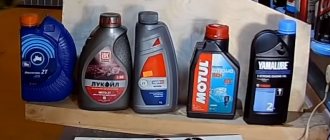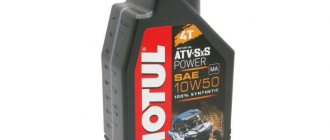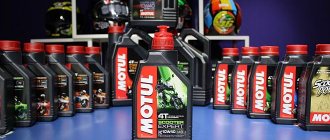In the Russian climate, a motorcycle cannot be called a practical transport, but two-wheeled vehicles are not losing popularity. A motorcycle can be chosen to suit every taste - from a touring enduro for long trips on any road to a heavy-duty sportbike. The characteristics of the engines are also extremely different; the operating conditions of a low-speed chopper and a high-speed sports tourer place completely different demands on engine oil.
Two-stroke models stand separately. Despite pressure from environmentalists, they still remain in motocross, living out their days on old road bikes. They require oils with a very specific set of properties, which is why two-stroke oils are separated into a separate group and can neither be replaced nor mixed with four-stroke ones.
Despite the fact that the main specialization of ROLF Lubricants GmbH is oils for passenger and commercial vehicles, agricultural and construction equipment, the company’s product line also includes motor oils.
What types of motorcycle oils are there?
The specific design of most motor engines is associated with the desire to make them as compact as possible. This is why on four-stroke engines both the clutch and gearbox are usually lubricated with the same oil as the engine itself. There are exceptions, and not only among heavy motorcycles. For example, on the Honda CRF450R motocross, the clutch and gearbox are separated from the engine lubrication circuit and operate on their own oil.
Motor oil for motorcycles with two-stroke engines operates under very specific conditions - its “life” cycle is short, and eventually it burns out in the cylinder. Therefore, the requirements for it are largely tied to the inevitable combustion of the entire volume of oil supplied to the engine, but not circulating in it.
General requirements
Motor oil is capable of performing all the functions assigned to it only if the design of the engine and its operational characteristics strictly correspond to the declared properties of lubricating fluids. This is the main condition that must be observed to increase the reliability of the internal combustion engine.
Modern oil compositions should have the following characteristics:
- High cleaning ability in relation to insoluble solid deposits (carbon deposits, scale, etc.), as well as timely and complete removal of them from the friction zone.
- Stable thermal and oxidative stability.
- Be compatible with sealing parts (rubber, polymers, etc.).
- Be characterized by low foaming and volatility properties (exhaust, fumes).
- Seal the temperature gaps between the elements of the piston group and limit the exit of exhaust gases through the combustion chamber as much as possible.
- Provide reliable protection of mechanism parts from corrosion.
- Remove heat from the cylinder block.
The oil film on the surface of rubbing parts must have sufficient viscosity under extreme temperature conditions, and be able to provide optimal protection to metal surfaces under conditions of boundary friction and exposure to acids formed during fuel combustion.
Oil for 2-stroke engines
Since the oil does not need a long service life, it does not contain stabilizing additives. But what is important for it is performance when mixed with gasoline (before the invention of separate lubrication, the only way to supply oil to a 2T engine was to add it directly to the fuel), cleanliness and low combustion smoke.
For this reason, mineral oils for two-stroke engines are not a good choice. Due to high smoke and abundant carbon formation, they heavily pollute the combustion chamber, piston crown, exhaust ports and muffler. This leads to a decrease in power and increases the risk of glow ignition. High-quality synthetic motorcycle oils can meet the most stringent quality standards available today, reliably protecting high-performance air-cooled engines.
What kind of oil to pour into the engine of an Alpha moped. : 10 comments
Thank you very much, I read all your articles and more and study them. In October 2021 I’m taking an alpha like 110, with a mileage of about 3 thousand km for 12 thousand rubles. At a friend's place. I am 28 years old, this will be my first motor. Previously it was 21099, I changed the clutch myself and cleaned, washed and adjusted the entire carbure. But I sold it because I didn’t drive it. Previously, I studied to be an auto mechanic, by the way, with honors... But for 10 years now I haven’t even read a single article about internal combustion engines and auto moto... I have gone very far from auto moto... I FORGOT EVERYTHING... And nostalgia has taken over. But still, having experience, albeit long-standing and theoretical, having ridden the alpha and studied it, I realized that the moped is affordable and normal for the money. And with proper care, it will please you. I decided to take it. At the same time, I’ll ask something about my future moped in your corresponding thread... I’ll wait for an answer. My name is Pasha.
Tell me, if the mileage on a moped is 70 km, and a year has passed, should the oil be changed?
I did not find any direct instructions in the instructions about changing the oil on time. And in theory it should be enough for 500 km. running-in. But oil loses its properties over time, and no one knows what kind of oil was originally poured. Therefore, to be sure, you can change the oil, especially since a liter of semi-synthetic now costs about 300 rubles.
If on the canister you filled it it is written that the expiration date is 1 year, then yes it is necessary.))))) If not. Then roll on some more kilometers...)
The fact of the matter is that there is no canister; with a mileage of 70 km, the oil must be filled in from the factory (or from the store where the moped was assembled). And what was poured there, and how long ago it was poured, no one knows. Of course, the oil lasts much longer than a year, but if in doubt, it’s easier to replace it and forget about it. Moreover, the replacement price is about 300 rubles + 30 minutes of time spent. Although I don’t think that if you don’t replace it, something terrible will happen in the 430 km remaining before replacement.
The oil needs to be changed anyway! The oil, even when not in use, comes into contact with air and therefore oxidizes. The shelf life of motor oil in sealed packaging is 5 years. If oil is used, as in our case, then it must be changed every year.
I'm sure I work with oils, chemicals, and car cosmetics. I know about polyalphaolefin oils, hydrocracking, and other crap. No nail or rod for everyone!
Yes. If the equipment is not used for a long time, the oil loses its properties.
Please tell me I have a semi-automatic transmission and am interested in what kind of oil to pour into it if the engines are already filled with 10w40
Most likely you have a semi-automatic clutch, that is, there is no clutch lever on the steering wheel. The box is almost the same. That is, oil is not poured into it separately.
To choose the right oil for a moped, consulting a salesperson in a store is not enough. Moreover, many of them have only superficial knowledge of the characteristics and properties of motor oils.
Motor oils should be selected depending on the engine installed on the motorcycle.
It should be remembered that in the regulatory and technical literature there is no special term “scooter oil”. However, in the store you often find oils specifically designed for motorcycle and moped engines. You can purchase them with confidence, paying attention only to what type of engine they are suitable for: two-stroke or four-stroke.
Oil for 4-stroke engines
In a four-stroke motor engine, oil circulates continuously throughout the entire interval between changes. Therefore, it must contain both viscosity stabilizers and detergent additives. For many motor engines, motor oil is a complete coolant operating in an air-oil cooling system.
Oil operating conditions and loads on it vary greatly from motorcycle to motorcycle. So, in a chopper with a water-cooled motor, these conditions are almost similar to those characteristic of car engines. In high speed engines both inertial loads and shear rates are very high. Therefore, in order to reliably protect the engine from dry friction, the oil must be of very high quality.
In air-cooled and air-oil-cooled engines, the oil can heat up to temperatures exceeding those specified by the SAE standard. That is why, for air vents, as a rule, the manufacturer indicates not only the oil viscosity, but also a complete list of those recommended for use. Such oils are guaranteed not to lose performance at elevated temperatures, are characterized by thermal stability and increased resistance to oxidation.
Most four-stroke motorcycles, as already mentioned, have a common crankcase with the gearbox. Therefore, the use of specialized oil for them is the best option, especially for the most powerful ones, where clutch slippage due to unsuitable oil will be immediately noticeable. The classification of oils for 4T motorcycles with a “wet” clutch is generally accepted according to the JASO standard; the current quality class is JASO MA2. But motorcycles with dry clutches and a separate gearbox are closer to cars in terms of oil requirements. In particular, these are:
- domestic Ural motorcycles, still produced in Irbit (mainly for export). Their clutch is dry and placed in a separate volume, the gearbox is lubricated with its own oil. However, the heat load of an air-cooled motor imposes its own limitations, despite the fact that the oil for the Ural motorcycle is not required to be marked 4T;
- BMW boxer cars, from the first models from the 1930s to the R1150GS. As a matter of fact, the layout of the BMW R71 was used on the first Soviet boxer - the M-72, which later gave rise to both the Irbit Urals and the Kyiv Dneprs. However, starting with the R1200GS, the engines began to be equipped with a multi-plate “wet” clutch;
- Classic Harley-Davidson big twins to this day retain a layout in which the engine has its own dry-sump lubrication system, not connected to either the clutch or gearbox. For some time, the primary gear and clutch were contained in a separate housing, so the motorcycle even used three different types of oil.
Rating of the best motor oils
10+. ZIC XQ LS 5W-30 4 l
This is a completely synthetic composition of very high quality. The production process used the most modern Low Saps technology, which ensures low sulfur, ash and phosphorus content. It can be used in gasoline and diesel engines equipped with a turbocharging system.
The oil is all-season and works well even in the most extreme temperature conditions. It extends the life of the motor and various types of filters aimed at reducing the emission of harmful substances into the environment. In the engine itself during operation there will be almost no soot and various types of deposits. The oil is acceptable for use in engines that comply with the Euro-IV standard, where a lot of attention is paid to the amount of emissions into the atmosphere.
Advantages:
- Low price;
- Retains its performance qualities for a long time;
- Holds high and low temperatures well.
Flaws:
- Only the highest quality gasoline should be poured into the engine with this oil;
- You can’t find it in every store; you often come across fake compounds.
GENERAL MOTORS Dexos2 Longlife 5W30 4 l
This is a synthetic oil that can be used at ambient temperatures down to -25 degrees, since when the engine starts, the oil pump must quickly deliver the composition to all rubbing elements of the mechanism. If this does not happen, friction and wear rates increase. In the summer, the oil retains its qualities at temperatures up to +50 degrees, due to which the engine does not jam during long periods of inactivity, for example, in a traffic jam, or if the cooling system is not operating correctly.
More: TOP 10 best walkie-talkies for hunting, tourism and truckers
This composition is intended for use in cars of most domestic and foreign brands, even if the gasoline was filled with low-quality gasoline. The cost of the oil is quite high, but its consumption is much less compared to other formulations, and you won’t have to add it too often. With the help of such oil, it is possible to achieve certain fuel savings; it extends the service life of various filters - oil and air. During operation, there are no air bubbles or foam in the oil. The manufacturer allows the use of the composition as a hydraulic fluid.
Can I use car oil?
Automotive oils, especially modern energy-saving ones, have fairly powerful anti-friction additive packages to increase efficiency by reducing mechanical friction losses. Therefore, in motorcycles with fairly powerful engines and a “wet” clutch, it is extremely undesirable to use motor oils due to the risk of clutch slipping and accelerated wear of its friction discs.
If on a motorcycle the lubrication circuit is separated from the clutch and gearbox, there are no special obstacles to the use of automobile motor oils. The only thing that requires attention is the heat load of the engines. Therefore, among oils of recommended viscosity, it is necessary to select varieties with maximum dynamic viscosity HTHS, measured at 150 °C according to the SAE standard.
Two-stroke engines
Sometimes sellers say that oil for two-stroke motorcycles has no classifications, and offer to buy products from the most famous brand at the highest price. However, there is not even a grain of truth in these words - there are two classifications developed by European and Japanese institutions. In Europe, the following division of oils into classes is accepted:
- TA - for mopeds and light vehicles with an engine displacement of no more than 50 cc;
- TB - for powerful engines with a volume of 100–300 cubic centimeters;
- TC - for all motorcycles with an engine capacity of more than 300 cubic centimeters;
- TD - for outboard motors. Its use in a motorcycle is undesirable.
The Japanese divide lubricants into FA - for highly accelerated engines, FB - for city motorcycles and FC - for mopeds.
It is also worth remembering that oil comes into a two-stroke engine only with fuel - therefore, strict proportions must be observed when creating the mixture. Unless otherwise specified by the manufacturer, 50 ml of oil should be added to a liter of gasoline if the engine has not been run-in and 40–45 ml after the end of break-in. If there is insufficient lubrication in the engine, scuffing may occur at high speeds, which can lead to major repairs. Some experts advise to always pour oil, but this recommendation is also difficult to call correct. A large amount will lead to its release from the exhaust pipe - the smoke will turn blue, and the engine will lose some power.
If you don’t have a special technical fluid on hand, you can add oil for 4-stroke motorcycle engines. It is much more expensive and contains a large number of additives that contaminate the internal components of the engine without burning completely. However, you will travel 100–200 kilometers without the slightest problem. But subsequently it is better to purchase two-stroke oil - it contains a large amount of solvent, which ensures uniform mixing with gasoline, and is also devoid of most dangerous additives.
Motor oil for motorcycles ROLF MOTO 2T
The composition of this oil is optimized specifically for motorcycles with two-stroke engines, including highly accelerated ones. It provides minimal smoke and carbon formation, fully meeting the requirements of JASO FD and ISO-L-EGD standards.
Motor oil for motorcycles ROLF MOTO 2T
ROLF MOTO 2T oil can be used in two-stroke engines with any type of lubrication. In the simplest engines, where oil is supplied mixed with fuel (standard concentration is 1 liter of oil per 50 liters of fuel), it guarantees the stability of the mixture without the risk of separation and the preservation of the octane number. Thanks to the stable viscosity, separate lubrication pumps operate reliably. A powerful package of anti-wear additives preserves engine life. The low ignition temperature and minimal ash content allow the oil to burn in the combustion chamber as completely as possible, without the risk of coking of the piston rings and failure of the spark plug.
Choosing the right oil
However, I decided to put together several companies that I think can be used in your scooter.
An excellent option would be a special oil for SCOOTER scooters. It is one of the most advanced and has also proven itself to be excellent.
Important: changing engine oil must be done according to the established plan and without time delays.
If you don’t look at the cost of the product, we have before us perhaps the best oil for a scooter motor if the mini-moped is purchased for many years.
Specifications
| Density at 15 °C, kg/m3 | 876,8 |
| Kinematic viscosity at 100 °C, mm2/s | 10,76 |
| Kinematic viscosity at 40 °C, mm2/s | 81,36 |
| Viscosity index | 118 |
| Flash point in an open crucible, °C | 158 |
| Pour point, °C | -42 |
| Quality classes | JASO FD/ISO-L-EGD, JASO FB/API TC |
| Tolerances | Rotax 253, Piaggio Hexagon |
Benefits of this oil
Keep in mind that in comparison with most synthetic products from other brands and manufacturers that are made on a hydrocracking basis, this product has an excellent ester base, which ensures operational stability. Also, SCOOTER oil is based on the maximum list of calcium and boron additives: including product analyzes do not show an increase in the amount of aluminum in the lubricant, which is why the wear rate of the pistons will be at the lowest level.
It would also be worth noting that modern SCOOTER lubricants already have a reputation as the most reliable among all - still, the oil was created specifically for scooters with four-stroke engines.
Among the advantages of the lubricant: it is able to maintain the viscosity indicator over time throughout the entire operation of the engine, without going beyond the established norm; the oil also demonstrates better ash content and an almost complete absence of deposits when used.
The viscosity indicator of the composition makes it possible not to worry about the level of performance of the scooter even at normal replacement intervals.
Source
Viscosity and classification
The viscosity of motor oil is extremely important for the normal operation of engines. On light motor engines, for example, most points are lubricated by splashing, that is, excessive viscosity will directly affect the service life. In air-cooled engines, there is a high probability of overheating, and hence a sharp drop in oil pressure. That is why they often still use ball and roller bearings for the crank mechanism. Unlike plain bearings (liners), which can be damaged if the oil pressure is reduced until the engine is overhauled, rolling bearings normally tolerate deteriorated lubrication.
Motor oils have not developed their own viscosity designation, but use the general standard SAE J300. It is quite suitable for water-cooled motorcycles, but air- and air-oil engines have their own nuances.
The fact is that high-temperature viscosity tests according to the SAE standard are carried out at two points. Kinematic viscosity is measured at 100 °C; when it falls within a certain range, the viscosity class is indicated. At the same time, for each class the standard specifies the minimum permissible value of dynamic viscosity at 150 °C. At the same time, in loaded friction pairs, especially in cylinder heads, the temperatures at the “air vents” can be much higher.
Top brands
There has long been a debate among motorcyclists about which oil is better. If we exclude domestic products, the number of brands in the motorcycle lubricant market will be relatively small. Most experts and owners of two-wheeled vehicles agree that Motul oil is the “golden mean” in terms of lubricating properties and additive content. Motul 300 V Competition oil is especially popular among racers - “synthetic” with moderate lubricating properties, which allows you to achieve maximum power of the power unit from the first seconds.
Shell products are a good option, but they are more likely to be counterfeited than others, so you should be especially careful when purchasing them. The main advantage of this manufacturer is a very wide range of products that are suitable for literally all types of two-wheeled vehicles. Owners of mopeds will be able to use Shell Advance Snowscooter, and for more serious two-stroke equipment it is worth stocking up on Shell Advance VSX 2. Owners of four-stroke city motorcycles prefer to use Shell Advance Racing X, and for two-stroke racing equipment Shell Advance Racing M is suitable.
Among the good brands, Castrol is also worth mentioning - the products of this manufacturer have a very high price, but almost never fail motorcycle owners. Good results are shown by products from such manufacturers as:
- Valvoline;
- Liqui Moly;
- Esso.
Texaco and BP oils have average performance, although they are quite sufficient for low-power equipment. Among the brands that should never be chosen are Ravenol and Motorex, since their oils are only suitable for scooters manufactured in the 90s and early 2000s.
There are often recommendations to pour regular automobile oil into motorcycle engines, since it has better properties. However, such advice will be completely irrelevant for owners of modern powerful equipment. With significant acceleration, the oil is pushed to the rear wall of the engine, making it difficult for it to enter the intake receiver. Automotive lubricants in motorcycle engines foam quite strongly, which leads to oil starvation and the appearance of scoring on the cylinder walls. The exception is domestic motorcycles and foreign low-power equipment (up to 20–30 horsepower), although here too the use of automotive lubricant is a risky step.
Motorcycle gear oil
If on a motorcycle the gearbox housing is separated from the engine and clutch, then most manufacturers require the use of 4T motor oils. Even the Irbit Motorcycle Plant, in the 2021 edition of the service instructions for the foreign market, indicates the need to fill the gearbox with four-stroke motor oil.
Motorcycle gearboxes with cardan drives initially use gear oil. For example, the factory requires hypoid gear oil with a high-temperature viscosity index of SAE 80 to be filled into the rear gearbox of the Honda GL1800 Gold Wing.
How often should you change the oil in your moped?
In the operating instructions, the first oil change (on a new moped) is after 500 kilometers (TO-1). The second replacement is at 1500 km (TO-2). The third replacement is at 3000 km. (TO-3). Then every 2000 km. But there is an indication that if the moped is operated under increased loads and in dusty conditions, the oil needs to be changed (maintenance) more often.
Personally, I change the oil every 1500 km.
How much oil to pour into an Alpha engine?
The owner's manual says to fill the crankcase with 0.9 liters of four-stroke engine oil. In practice, it may turn out that not all of the old oil has left the engine. I usually do this: fill in 0.8-0.85 liters of oil, control its level with a dipstick and top up if necessary.
Common Myths
You can often hear that it is best to fill air-cooled motorcycles with the thickest oil possible, like SAE 10W-60. In fact, it does more harm than good.
It was already mentioned above that the engine is largely lubricated by splashing. With thicker oil, of course, the engine will run quieter, the oil pressure will be more stable, but the wear of many components will accelerate. Thus, the valve drive mechanisms in lower engine engines will begin to suffer, and less oil will get into the cylinders if the engine does not have forced oil supply channels. As a result, trying to improve the engine's performance will only harm it. The oil viscosity recommended by the manufacturer is best suited for it.
Doubts
I, the author of these thoughts, like many others, poured Motul 8100 into the engine of my car and later, motorcycle oil into pit bike and enduro engines. But the small (1.6 liter, 160 horsepower) engine of the car, despite timely replacement every 7,000 km, successfully coked, the rings sat out and no miracle happened, the oil was growing worse before our eyes. Of course, we can say that the reason is not the oil at all, but this at least suggests that it is no better than the others. But my fears were confirmed by the owners of the same cars; members of the auto club completely switched to oils of other brands.
The familiar packaging of Motul 7100 oil
The second signal that there is no need to trust blindly came from the reviews of athletes and those who work with them. A motocross rider I know used this oil and his engine failed several times during the season. After switching to another brand, the situation with the engine returned to normal and serious breakdowns disappeared.
The guys close to the sports motard crowd were categorically against it, since they are constantly present at the sports track and said that among amateurs, the engines of evil Motard motards run out as quickly as grandma’s pies. And those athletes who race under Motul sponsorship change their oil every race.
Another factor against Motul is the high probability of running into a fake. There are constantly broadcasts on TV about the discovery of more and more clandestine factories producing oils on an industrial scale. A typical motorbike enthusiast buys expensive motor oil in a store and, without knowing it, is approaching a major engine overhaul.
Popular is not always appropriate
Semi-synthetic oils, mainly viscosity grade 10W-40, are the most popular. However, they cannot always be used on all motorcycles. Before choosing the right oil, check the requirements of the manufacturer of the two-wheeled vehicle. In this case, we are talking mainly about compliance with quality requirements (the so-called API quality class - American Petroleum Institute) and SAE viscosity. Among the latter, there are six classes of winter and six-year viscosity. Using the wrong oil can have various consequences. If we use an oil with too low a viscosity, we expose the oil pump to damage, and if we use an oil with too high a viscosity, we limit the service life. Bolts, pistons, rings and camshafts have to be replaced, mainly due to their increased wear due to friction.
motorcycle oil
How to choose the right oil for your motorcycle
Post Views: 1,364








